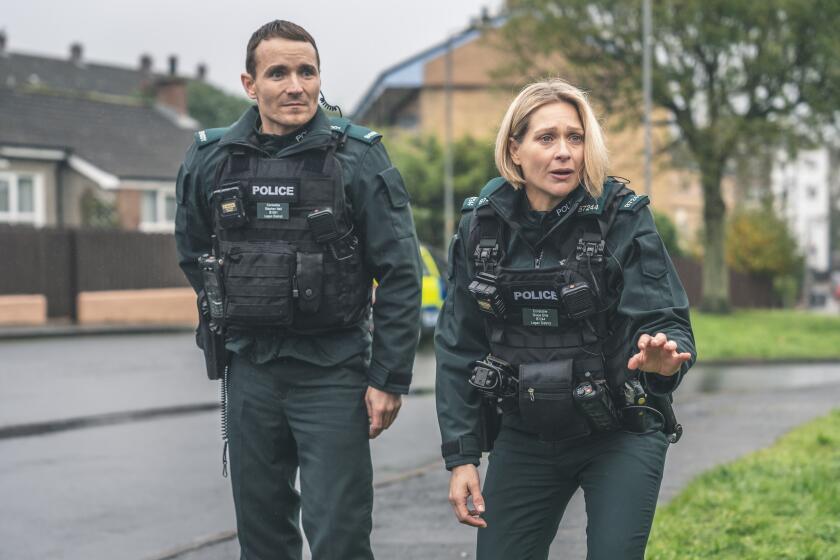‘Say Nothing’ explores ‘human wreckage’ wrought by young radicals during the Troubles

- Share via
It was probably inevitable that Patrick Radden Keefe’s gripping 2019 bestseller “Say Nothing: A True Story of Murder and Memory in Northern Ireland” would be adapted by Hollywood.
Part thriller, part true-crime investigation, the nonfiction book uses one of the most heinous unsolved crimes of the Troubles — the 1972 disappearance of Jean McConville, a widowed mother of 10 who was abducted from her Belfast home by intruders assumed to be members of the Irish Republican Army — to explore the lingering trauma of political violence on survivors and perpetrators alike.
Like a nonfiction novel, Keefe’s book traces five decades of thorny history from the perspective of real-life characters, including the notorious Price sisters, Marian and Dolours, IRA militants whose prison hunger strikes made front-page news in the 1970s, and Gerry Adams, the political leader who helped bring peace to Northern Ireland but has been accused of participating in atrocities committed during the height of the conflict.
Declan Lawn and Adam Patterson are the creators of the BBC series “Blue Lights,” a procedural that follows a trio of recruits to the Police Service of Northern Ireland. Season 2 is now on BritBox.
Keefe was inspired to write the book in 2013, after reading an obituary for Dolours Price, who in her later years spoke about the psychological toll of her IRA activities and accused Adams of ordering attacks she carried out. (Adams has repeatedly denied any involvement with the paramilitary group despite significant evidence to the contrary.)
“The thing that was most interesting to me from the very beginning, is what happens when somebody who is at the vanguard of political radicalism in their youth gets older?” Keefe said. ”What happens when the political circumstances change?”
A timely nine-episode adaptation developed by FX arrives Thursday on Hulu and raises questions about how a bitterly divided country can move on from the past, something that will feel relevant to many American viewers now. Translating “Say Nothing” to the small screen in a way that was both authentic and accessible to viewers who “can’t find Northern Ireland on a map” was a priority, said Keefe, who served as an executive producer on the series. “We were mindful of the fact that this has to work as a story, and it has to work for people who aren’t scholars of the Troubles.”

Created by Joshua Zetumer, the series follows Dolours (Lola Petticrew) and Marian (Hazel Doupe), idealistic activists who quickly grow disillusioned with nonviolent resistance to British rule and decide to follow family tradition by volunteering with the IRA. Taking a cue from their Aunt Bridie (Eileen Walsh), who was blinded and disfigured in an explosives accident as a young woman, they insist on being active participants in the struggle.
As soldiers in a guerrilla war, they prove to be just as committed as their male counterparts, including a young Gerry Adams (Josh Finan) and his IRA comrade Brendan Hughes (Anthony Boyle), who play crucial but supporting roles in the story. Even when asked to complete devastating tasks, like facilitating the executions of close friends, they don’t flinch. A separate thread in the series follows the McConville children over the decades, as they fight an impenetrable code of silence to uncover the truth about their mother.
“What we’re trying to do is be close enough to these young women that you can understand how, in their late teens and early 20s, they would join a paramilitary organization, believing that peaceful protest is never going to work. We want you to be there with them, but then also to see the human wreckage of their decisions,” Keefe said over breakfast in Manhattan, N.Y., where he was joined by Zetumer and director Michael Lennox. (The irony of the setting, a luxury midtown hotel where a bowl of Irish oatmeal costs $28, was lost on no one, particularly when the waiter came to take our order just as the conversation turned to the hunger strikes in the series.) The idea was to be sympathetic enough that viewers would conclude “these young women were not psychopaths” even if “they made different choices than you or I would have made.”
Adapting the book was “one of the most difficult challenges I’ve ever had as a writer,” said Zetumer, whose credits include “Patriots Day,” a dramatization of the 2013 Boston Marathon bombings. Ultimately, much of the material in the book, including Hughes’ cinematic escape from prison and multiple grueling hunger strikes, was cut so that the Price sisters’ journey of radicalization and regret would take center stage. “We really tried to ground it in the emotional perspective of the characters at every moment,” Zetumer said.
As a mostly American group telling a story about Northern Ireland, the creative team also valued authenticity. Lennox, a Belfast native who previously worked on the Troubles-themed coming-of-age comedy “Derry Girls,” played an essential role in setting its tone, which, though grim, also is inflected with dark humor.

Lennox read the book after a friend gave it to him several years ago and, like a true Irishman, was skeptical that an outsider could capture the complexities of his community.
“My first response was, ‘Who’s this guy writing a book about Northern Ireland?’ ” Lennox recalled. But he was won over. “It was extraordinarily moving to me.” When he heard that FX was developing the project for TV, he reached out.
“It was important for me that we catch the spirit of Belfast, especially through casting,” Lennox said. He had worked with Petticrew and Boyle, childhood friends who grew up near each other in Catholic West Belfast, a decade earlier on an anti-drug film, and was instrumental in casting them. Many of the cast and crew had connections to the real-life people in the story. (This commitment to authenticity had its limits, however: Though some exteriors were filmed in Belfast, which has become a production hub thanks to “Game of Thrones,” the bulk of the production was shot in England, partly to avoid triggering residents by re-creating traumatic events.)
“When you grow up in a place with that history, it’s your normal,” said Petticrew, in a Zoom call with Doupe, their co-star. (Petticrew uses they/them pronouns.) “It was something that I felt like I could bring some authenticity to. Dolours and I went to the same school, we grew up in the same background. I knew in my heart and soul that I had to do it.”
Many of the characters felt familiar to Petticrew. “It was both a blessing and a curse, because I felt real pressure to get it right for everybody here,” they said.
‘Derry Girls’ creator Lisa McGee breaks down the Netflix series’ final season, including its ‘tricksy’ timeline and THAT surprise cameo.
Perhaps more than an actor raised outside of Belfast, Petticrew was able to understand on a visceral level what compelled Dolours to commit acts of terrorism. “They were colonized people, and I’m still a colonized person,” they said. Petticrew, 28, is a “ceasefire baby,” part of a generation that grew up during a fragile peace but still grapples with social division, economic inequality and intergenerational trauma. “If I had any worries at the start, before reading the scripts, it’s that it would be the sort of show that was like, ‘We had the Troubles, it’s done, and this is what we think of it.’ What the show does incredibly well is dancing in the gray area. It presents these people in an incredibly complicated situation, and it doesn’t make any moral judgments,” they said.
For Doupe, who is just 23 and is from the Republic of Ireland, the Troubles represented less familiar terrain. “When it did crop up occasionally through my childhood, it could have been happening in a different country for all we knew. It just felt so far removed,” she said.
Still, she was able to relate to Marian, the quiet yet flinty younger sister who looks up to the fiery Dolours. “Your job as an actor is to understand all of the actions and not necessarily agree or disagree with them. That’s for the audience to decide, and that will change as the series goes on. You’re meant to sometimes agree with them and sometimes not. And I think that’s really beautiful.”

The actors bonded instantly and had “an almost telepathy by the end of the shoot,” Zetumer said. This connection helped Doupe and Petticrew get through some dark days on set and also served the storytelling well: The Price sisters have what can only described as an intense, codependent relationship, which becomes even more deeply intertwined during their imprisonment. (Doupe and Petticrew play Marian and Dolours as young women; Maxine Peake and Helen Behan play them in middle age.)
“Say Nothing” is also unique because, unlike other pop culture accounts of the Troubles, which tend to focus on men (see: “In the Name of the Father,” “Hunger”), it uses a female lens, said Petticrew: “It’s told from the point of view of women who had a massive role in what happened. Growing up, we knew the names of the 10 men who died in the hunger strike in ’81. But they wouldn’t have been able to die had it not been for what the Price sisters went through.”
The Prices were motivated by “a funny version of feminism, where the glass ceiling is whether or not you’re allowed to shoot a gun at policeman,” Zetumer said.
Some of it was about equality for women, “Like, ‘Listen, times are changing around here. We need to be able to do what the guys do,’ ” said Keefe. But the Prices were also raised by parents who were renowned in Irish Republican circles. “Dolours and Marian were kind of IRA nepo babies. If anybody’s gonna be the first woman who gets a better opportunity than anybody else, it’s going to be be Albert Price’s daughters.”
Perhaps more than anything, “Say Nothing” captures the ideological fervor that often characterizes the very young: Marian was only 17 when many of the events in the series take place, and Dolours barely in her 20s. The show was in development over the last five years, against the backdrop of events like the Black Lives Matter protests.
“You’d see the protests and sometimes the person holding the bullhorn would be 17 years old,” Zetumer said. “A guiding principle for us was capturing the energy of what it feels like to be a teenager and get really swept up in something.”
More to Read
The complete guide to home viewing
Get Screen Gab for everything about the TV shows and streaming movies everyone’s talking about.
You may occasionally receive promotional content from the Los Angeles Times.








